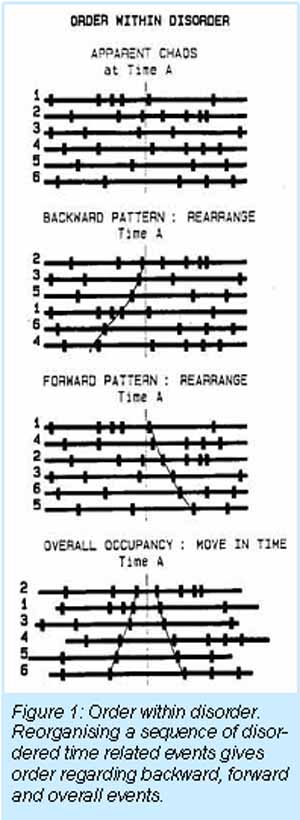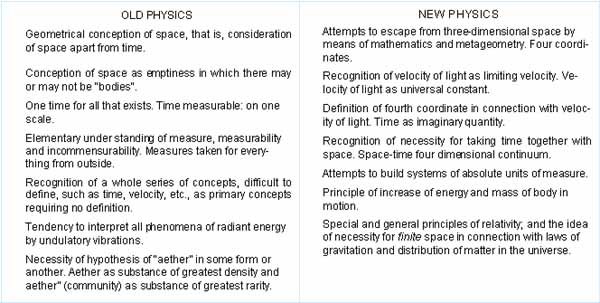Nosokinetics
Measuring and modelling hospital care: old or new physics
By the Editor, Peter Millard
(comments to rjtechne@iol.ie)Figure 1 0K The OLD Physics boxes are after the second line in A new model of the Univers In this article I use six-line models and Ouspensky's 1931 analogy between old and new physics to consider the different ways of measuring time in moving systems. In the following three issues Mark Fackrell from Melbourne will discuss the concepts that underpin phase type models.
Einstein's conundrum
When he was a young man, Einstein asked himself : "What would I see if I were travelling along at the speed of light?"He answered himself: "I will see the light waves going up and down.".
We travel through hospitals at the same speed as the patients. We know that patients flow through hospitals in streams, for terms like slow stream rehabilitation are used to describe a certain type of care. However, we are moving in time at the same speed as the inpatients. Could Einstein's conundrum explain why we simply measure the patients coming in and out?
Waves of patients
In the eighteenth century Thomas Young observed that light shone through a slit created stripes of light and dark. Watching the interactions between the high and low waves of flow behind two ducks (on the river Cam) Young also deduced that light had both particles and waves.Physicists now know, if they measure the waves they don't find the particles and, vice versa, when they measure the particles they don't find the waves. But we can, as Gary Harrison said when he was creating the mathematical solution to a two compartmental model of flow: "We have an advantage over pharmacologists because we know when every molecule (patient) arrives."
Order within disorder
Figure 1, from my 1988 MD thesis, shows by ordering and reordering a time series of events we can get different insights into the process of inpatient care. Four states can be seen:1. Apparent chaos: Six lines, 33 events. Each line (bed) with a different time related sequence of events. i.e. the scene when one starts a ward round.
2. Backward pattern: Rearrange the sequence of present events and plot the time the time elapsed since admission, i.e. the pattern used, subconsciously, in the post-take ward round when the current status and future prospects of each patient is discussed.
3. Forward pattern: Stand still in time and plot the time when the current inpatients leave.
4. Overall occupancy: Shuffle the pack and make the mid point of each patients stay the same.

Figure 1: Order within disorder. Reorganising a sequence of disordered time related events gives order regarding backward, forward and overall events.
Time is the fourth dimension of space
Everything we see is in the fourth dimension of space. But time itself has three dimensions. Everything present was created by events and decisions made in time past. How we interpret the current scene depends on a whole host of factors, our knowledge and past experiences. The fifth dimension of time is the decisions made in past time that created what we see and how we interpret it. And the sixth dimension is all the other decisions that could have been made in time past which would, for better or worse, have created a different picture.Perhaps to make it clearer. Consider you have lost your way in a city. The fourth dimension question is "Where are we?" The fifth dimension question is "How did we get here?" The sixth dimension question is "Where would we be if we hadn't turned left or right at the last junction?"
Clinical trials: the fatal flaw
The fatal flaw of basing policy decisions on random allocation controlled trials is that the mathematical approach compares a fourth dimension problem with a fifth dimension answer. The implication being that the fifth dimension answer is preferable too and better than all other actual and potential 6th dimension methods of improving the outcome of care.Moreover, in random allocation clinical trials, unlike placebo controlled drug trials, the staff and patients know the outcome that is expected. Hence the prophecy has its own fulfilment and no-one should be surprised that the new approach is statistically different from the old. To solve the problem we need to harness the power of modern computers to escape from old physics and embrace new methods of measuring and modelling the process of care.
Old and new physics
In 1931 P.D. Ouspensky, a Russian mathematician and philosopher outlined the differences between old and new physics. (Table from Arkana London 1984 English translation 'A new model of the universe').

Figure 2: Tables from Ouspensky's book.
Conclusion
There is an uncanny relationship between the principles of old physics and current methods of measuring inpatient activity. Emptiness. One time for all that exists (midnight in UK, 8.00 am Australia). Elementary understanding of measure and measurability (averages of skewed distributions) Measures taken for everything from outside (annual statistical returns). Recognition of a whole series of concepts, difficult to define such as time, velocity, etc. primary concepts requiring no definition fell. In 1987 reading the above I realised that I had to reject Newtonian concepts of pressure and force and seek answers to the rise and fall of admissions to my department in new physics. The rest is history.
Some navigational notes:
A highlighted number may bring up a footnote or a reference. A highlighted word hotlinks to another document (chapter, appendix, table of contents, whatever). In general, if you click on the 'Back' button it will bring to to the point of departure in the document from which you came.Copyright (c)Roy Johnston, Ray Millard, 2005, for e-version; content is author's copyright,